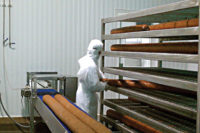Striving for the perfect slice, stack and portion in the meat and cheese industry can be quite the endeavor, as there are many variables in obtaining that perfect slice. There are many ways to ensure the final product is the right product; however, there is only one way to ensure that particular product stays consistent. Some might call it the “Art of Preparation.”
Just as we recently witnessed in the Olympic Games in Sochi, the success of many winning athletes stemmed from preparation for their activities, not necessarily the heat of the competition. If one were to interview these winners, they would indicate their training had more to do with their success than anything else. Slicing meat is very similar, though it may not be an athletic activity. Having the newest slicers or most automated line will not guarantee proper slicing and acceptable yields. In this article we will review the basic principles to proper slicing and will illustrate the necessity for proper preparation.
Log preparation is a critical step in the slicing process. Though it would seem common sense that high-quality logs are essential, one would be astounded to see how often malformed and inconsistent logs plague a company’s bottom line. Most slicing operations are set up to slice a targeted portion weight of meat containing a desired slice weight and thickness. Therefore, modern slicers have automated feedback systems to auto adjust the slice thickness to accommodate for differing dimensions of slicing logs. So if the log is very consistent, the machine will have to adjust very little to achieve a targeted slice weight, slice thickness and portion weight. On the other hand, if the meat logs are inconsistent the machine is continually adjusting, leading to thick and thin slices, poor yields and poor performance.
There are two essential factors in preparing for perfect slices: product temperature/density and slicing blades. Product temperatures for ready-to-eat products usually range from 28 degrees to 32 degrees Fahrenheit. Having the right product temperature is crucial because it alters the density of the product being sliced. If the density of the product is greater, the product then becomes more firm and consistent, resulting in a better quality of finished slice. Having these colder temperatures is essential because at higher temperature it will usually mean the product is at a lower density making it 1) softer to slice, which can cause shredding, and 2) more likely to stick to the blade. However, for products such as bacon or dry sausage, the natural state of the product will be dense enough to slice at warmer temperatures. Unfortunately, too much of a good thing can be a bad thing. If one gets the product too cold, it will freeze which can damage the meat’s internal cell structure. Many operations have found crust freezing is a better solution because in this process a thin layer of the outer surface frozen, but the inner portion of the meat is not.
Having the right product temperature can make all the difference in determining a perfect slice, but even the best slicer can only achieve marginal results without one other factor: the right blade. Usually, the manufacturing plant must rely on vendors to recommend the proper blade for a specific application. There are many nuances about slicing blades and one should rely on experts to help select the right one.
Blades are only as good as they are cared for, though. It is essential that blade maintenance be practiced. This comes down to simple things such as the way the blades are handled on and off the machine to more complex applications such as the ways in which the blades are sharpened. These activities include making sure tolerances are within specifications for the blade. A routine blade inspection program should also be in place to make sure the manufacturer’s recommendations are being met.
Slicers also require routine maintenance, which is no different than other machines in the facility. Preventative activities such as bearing replacement, lubrication, conveyor alignment and inspection are simple yet essential daily activities to keep a machine running as it is designed to. There should be detailed setup instructions for operators with information as specific as torque of the slicer blade bolts. Lastly, recipes that outline specific product slicing settings should be available for the operator, or preferably stored in the software of the machine.
Good performance of slicing equipment is not solely attributed to buying the best slicer and turning it on. It is a good start, but really good slicing performance is related to proper preparation of the meat and the machine before anything ever gets sliced.








Report Abusive Comment